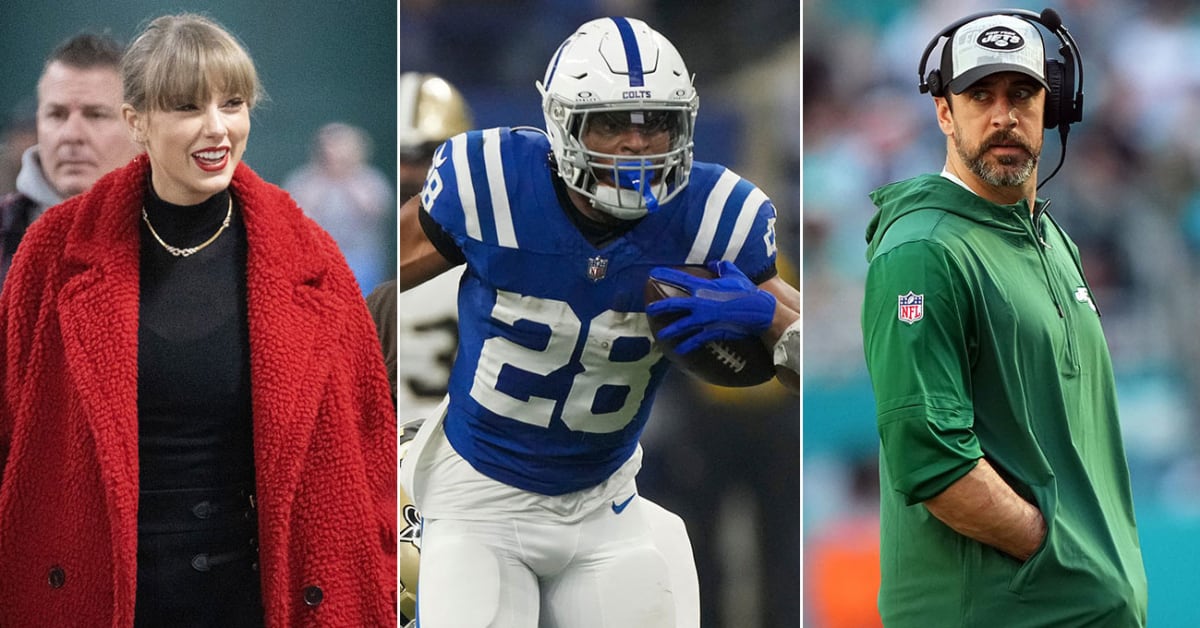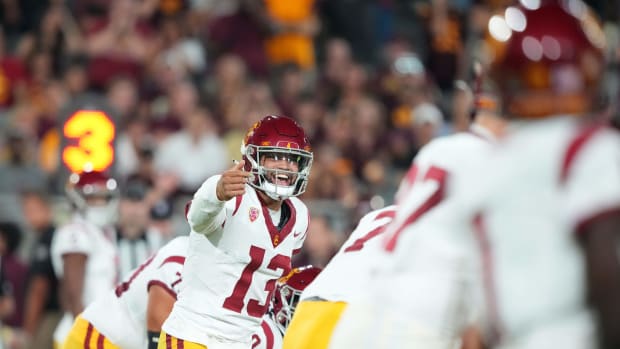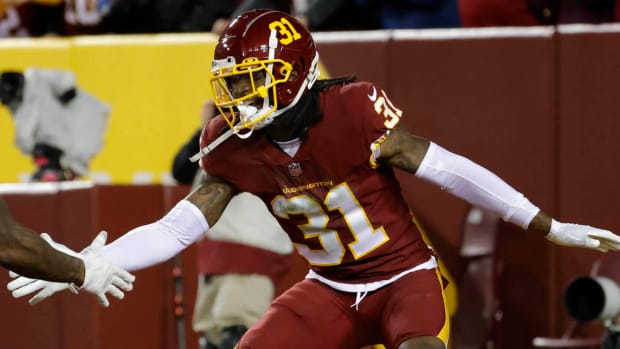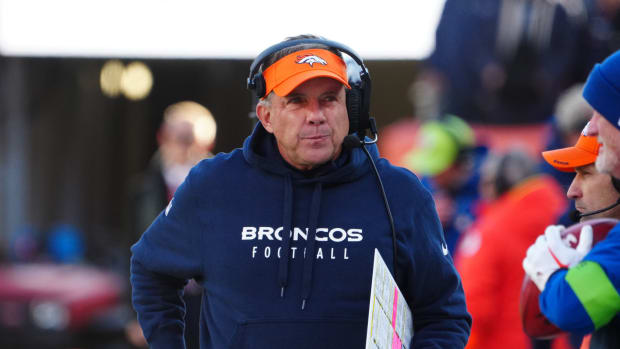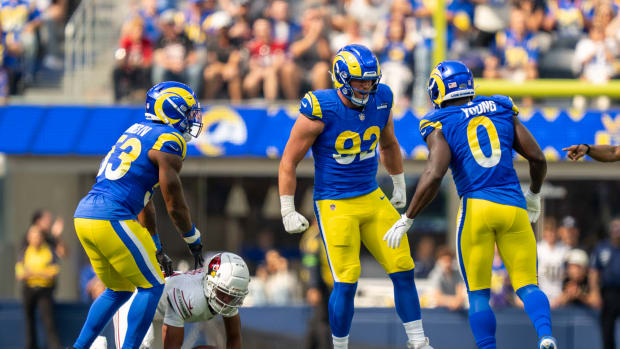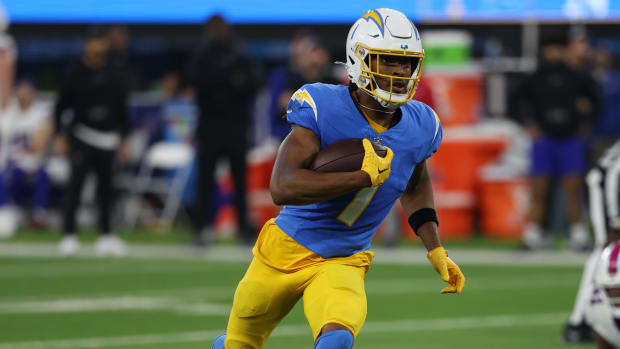NFL 2023: Top 10 Business of Football Stories of the Year
As I always say, the games are just the storefront of the NFL; the real work is done behind, around and inside the games. And while the games occur during five months each year, the business of the NFL inexorably marches on, in-season and offseason, with never-ending issues. With that said, here is my list of the NFL’s 10 biggest business of football stories of 2023.

Swift, Taylor and Rodgers were among the biggest NFL off-field newsmakers this year.
Mark Hoffman/USA TODAY Network (Taylor Swift); Robert Scheer/IndyStar/USA TODAY Network (Jonathan Taylor); Jasen Vinlove/USA TODAY Sports (Aaron Rodgers)
America (and the NFL) loves Taylor and Travis
One of the NFL’s most recognizable players started dating one of the planet’s most recognizable people, and an explosion of interest and intrigue ensued. The romance between Chiefs star tight end Travis Kelce and pop megastar Taylor Swift is now in its fourth month. We have seen Taylor in stadiums from Kansas City to New York to Green Bay, and Travis soaking up a Taylor concert (where he was mentioned in song) in Argentina. The romance is real, and it is spectacular.
And it is a boon for business. The NFL scores with most demographics, but it probably wasn’t doing as well as it is now with women, thanks to Swift. The memes of women lecturing their men about this football player (Kelce) whom Swift was making famous were amusing, as were men (including the Kelce brothers on their podcast) explaining the basics of football to newcomers to the sport.
As I noted during the games with multiple cutaways to Swift in the box: Serious football fans were yelling, “Stop showing Taylor!” at their TVs, while millions of others were yelling, “Show more Taylor!”
Whether the romance lasts or ends with some of the greatest breakup artistry in the history of music, it has been the top business of football story for the NFL this year. We’ll always have Swelce in 2023.
Aaron and the Jets
Aaron Rodgers emerged from the darkness (literally) in February to discover (1) the Packers were indifferent to his return, ready to move to a Jordan Love future; and (2) the Jets were ready to begin a courtship that eventually led to marriage.
Just as they did 15 years ago with another Hall of Fame Packers quarterback, Brett Favre, the Jets took a big swing here, and it was quite an offseason honeymoon that featured a Hard Knocks centered on Rodgers.
Of course, things changed four plays into the season, and Rodgers spent most of his first year as a Jet in Achilles tendon rehab in Los Angeles. The Jets went back to the quarterback they tried so hard to replace with Rodgers, Zach Wilson, and the results showed. The big swing on Rodgers will wait another year, when he has $37 million guaranteed awaiting him, before a full evaluation.
As for the Packers, they scored well on the trade, as I suggested they would from the start. They secured two high-second-round picks and offloaded $108 million (now $75 million) for a player (1) they had replaced, (2) who was never going to play there again and (3) for which the Jets were the only suitor. That’s not to absolve the Packers of any mismanagement here, though: It remains curious why they went all in for 2022, leaving a $40 million hole in their cap for Rodgers in ’23.
Speaking of Rodgers …
NFL takeover of Black Friday
The NFL has become a staple of Sunday afternoon behavior for tens of millions of Americans. And Sunday night. And Monday night. And Thursday night. And now at least one Friday.
The biggest NFL business story of 2022 was the NFL’s securing media deals worth a combined $110 billion—$11 billion or so from Amazon, which purchased exclusive rights to Thursday Night Football for a decade. Amazon founder Jeff Bezos doesn’t need to own a team; he owns all the teams for one night a week. And now he also owns them for Black Friday, starting with the Jets-Dolphins game this year.
Amazon (and the NFL) was quite strategic here. They gained programming on a holiday with little sports programming and kept 12 million-plus viewers engaged on Prime and theoretically out of brick-and-mortar businesses on the busiest shopping day of the year. Diabolical.
Although that was a one-off for Amazon, I cannot see how it won’t continue. Amazon and the NFL on Black Friday will, in my opinion, be a constant every year going forward.
Quarterback riches, team structures
Lamar Jackson, Jalen Hurts, Justin Herbert and Joe Burrow (in that order) all negotiated five-year extensions, with the values of those extension years totaling between $250 million and $260 million.
Jackson, negotiating from the strength of a franchise tag, has the most valuable contract, a true five-year deal worth $260 million: $52 million a year, with $80 million in 2023 (making him far and away the highest-paid player in the NFL this season). Hurts had a year left on his existing contract, giving him a six-year deal worth about $259 million and a true average of $43 million. Herbert and Burrow had two years left on their rookie contracts, giving them seven-year deals worth $219 million and true averages of $44 million. The money in these deals is strong. But …
Structurally, the teams—not the players and agents—got what they wanted. Team negotiators successfully pushed back against the full guarantee structure in Deshaun Watson’s contract, reverting to the traditional team-friendly structure of two to three years guaranteed and the rest, well, up to the team. This cycle of elite quarterback contracts has made the Watson deal look like the aberration the NFL owners claimed it was.
Following these deals, the Chiefs finally adjusted the inequity of Patrick Mahomes’s contract. The renegotiation brought his four-year compensation between the years 2023 and ’26 to the league’s highest level, although it did not address his vastly below-market pay since his extension in ’20, nor his future pay for the five years he is still under contract after ’26.
At any pay level, however, having players such as Mahomes, Hurts, Herbert, Burrow, Josh Allen and more under long-term contracts are more wins for the teams. None of these players will even be able to sniff free agency through the decade.
Speaking of quarterbacks …

Burrow is one of many star quarterbacks to have his 2023 season cut short by injury.
Sam Greene/The Enquirer/USA TODAY Network
Season of quarterback injuries
Injuries are clearly part of the game of football, a sport with an injury rate per player of, well, 100%. As Vince Lombardi said: Football is not a contact sport; it is a collision sport. And for this season, at least, injuries have seemed to afflict more of the top players at the game’s most important and popular position than ever before.
Here are some of the major quarterbacks who have missed significant time this season due to injuries:
• Aaron Rodgers
• Joe Burrow
• Deshaun Watson
• Kirk Cousins
• Kyler Murray
• Daniel Jones
• Justin Herbert
• Justin Fields
• Anthony Richardson
• Ryan Tannehill
The above represent roughly one-third of the starting NFL quarterbacks, the marquee position in the sport that drives the product and moves the marketing needle. The good news for the league is that its incredible popularity and prosperity have not appeared to be affected, with ratings once again skyrocketing for all coverage. Indeed, ratings for Jets’ games have soared this year despite Rodgers’s playing only four plays.
From a team perspective, however, these are tough blows. There is such reliance on these players on the field and such resource allocation for them off the field in cash and cap. As my former general manager in Green Bay, Ted Thompson, used to say: “Injuries are the bane of our existence.”
Running back dystopia
We have known for some time that running backs are low on the scale of NFL position pay. But we did not know how low until this year.
To be clear, I don’t think it’s that running backs are not considered valuable. I think it’s that running backs of a certain age—say, over 25 or 26—are not considered valuable. With the shortest shelf life in the sport, running backs are the gymnasts of the NFL.
Ezekiel Elliott and Dalvin Cook, among the league’s most productive running backs in the not-too-distant past, were released from the Cowboys and Vikings, later finding new homes with dramatically reduced pay. The highly productive Austin Ekeler made some noise about his contract; that noise was met mostly with crickets by the Chargers. Three top running backs—Tony Pollard, Josh Jacobs and Saquon Barkley—were saddled with franchise tags with no serious long-term negotiations from their teams (and if they’re not getting long-term deals this year, they’re definitely not getting them when they’re a year older). The disrespect to the position seems to increase every year.
Running backs are disadvantaged both coming into the NFL—burdened more than other positions by the three-year draft eligibility rule—and later in their careers, when teams look to replace them with younger, more dynamic and cheaper running backs.
There was some mild hope for the position when Jonathan Taylor (24 years old) inked a new deal with the Colts for roughly $11 million a year for the next three years. However, even that top rate for running backs is (1) less than half of the top rate for wide receivers, (2) a third of the top rate for defensive linemen, and (3) and a quarter of the top rate for quarterbacks.
I feel for NFL running backs. They truly need a labor union of their own.
“Commander-ing” a record price
Although it has been a few months since the deal was consummated, the purchase price of the Commanders is still mind-blowing.
It was truly a great day for NFL owners this summer, when in a special league meeting they hit on the exacta. In one fell swoop they (1) rid themselves of former partner Daniel (Mr.) Snyder and (2) approved an eye-popping $6.05 billion sale of the Commanders, to Josh Harris. The pictures of NFL owners featured ear-to-ear smiles after that meeting.
Five years ago, the Panthers sold for a record $2.275 billion. Last year, the Broncos more than doubled that, selling for $4.6 billion. Then a year later, Snyder exited the league with a pure platinum parachute worth over $6 billion.
The magnitude of this price has caused NFL owners to analyze potential investment from a different type of investor than previously considered. The NFL has always been loath to consider institutional money; that may be changing due to the skyrocketing franchise prices. There are only so many individual multibillionaires out there; corporate investment is coming from different potential sources: private equity, sovereign wealth funds and, yes, perhaps even the Saudi Public Investment Fund. Maybe not this year or next year, but it is coming.
Bills and Titans score deals of the year
While Lamar Jackson and Joe Burrow signed for total values of $250 million to $300 million this year, NFL owners in Buffalo and Nashville secured deals that are three-to-four times more valuable than that.
In March, the Bills received $850 million of public funding toward the building of a new stadium: $600 million from the state of New York and $250 million from Erie County.
In April, the Titans made the Bills’ stadium subsidy seem pedestrian. They received $1.26 billion ($760 million from the city of Nashville and $500 million from the state of Tennessee) toward the building of their new stadium.
Of course, these team owners, with $5 billion franchises and media contracts worth more than $100 billion, can afford to build their own stadiums. But they can leverage even the slightest thought that they may move elsewhere. And where were they going to move to? St. Louis? San Diego? Toronto? Please. They weren’t going anywhere, but the perceived threat worked.
These are up there with the best deals in the history of the business of sports.
Socialize cost, privatize profit.
The third team on the field
There has always been questioning of NFL officiating, but for whatever reason, there is a crisis in public confidence of NFL referees this year.
Perhaps a reason for this is blown calls in stand-alone, prime-time games involving the defending Super Bowl champion Chiefs. In one late-game drive against the Packers alone, the Chiefs were (1) beneficiaries of a clearly erroneous hit-out-of bounds penalty, and (2) victims of a clearly erroneous noncall that was blatant pass interference. A couple of weeks later, a game-changing offsides call against, again, the Chiefs drew uncharacteristic reactions from Patrick Mahomes and Andy Reid (Mahomes was fined $50,000; Reid, $100,000; ). Ironically, as Roger Goodell noted, those reactions were to an offsides call that was—wait for it—the correct one.
I’m not sure why the officials are more part of the story than they have ever been, but I am sure there is a way—beyond making them full-time—to improve things. That is to take some of the “human” out of human error.
Professional tennis went from having six to eight linesmen officiating the match to having no linesmen at all. Every call is electronic, judging ball location down to the millimeter, and there is never an argument from players or coaches … ever.
I know, a football field is not a tennis court. But I am confident there are ways to technologically upgrade the administration of NFL games to know exactly when a ball has crossed the goal line, sideline, first-down line, crossbar, etc. This is not something that is beyond the reach of technology.
A business approaching $20 billion a year in annual revenue is still being officiated the same way it was when it was approaching $20 million a year in annual revenue.
We will all laugh one day thinking about when the NFL judged first downs with two sticks and a chain (and, sometimes, a notecard).
Football beyond our borders
As general manager of the Barcelona Dragons of the World League in 1991, I was part of the NFL’s first iteration of trying to expand its footprint internationally. There have been many fits and starts since the NFL streamlined its international business to stand-alone games overseas.
There is now a steady diet of two or three London games per year, with the Jaguars the menu item that never changes. There were two games in Frankfurt (I attended one) in 2023, and the NFL just announced a ’24 game in Sao Paulo, Brazil.
As we know, the NFL is the most popular and profitable sports league in this country; it’s not even close. But the league has not yet monetized what is available beyond our borders. The announcement of the game in Brazil is a step in that direction, with rumors of games in Spain, Australia and other markets to come. Soccer will always be king in those countries, but the revenue and market penetration opportunities for (American) football are there.
As I have said often, I do not predict an NFL international team or conference, but I do predict an NFL international schedule, perhaps as soon as next year. Eight international games, 16 teams a year (with hosting teams from the conference with nine home games that year, as the AFC was this year), every team playing an international game every other year. Simple and, most important, competitively balanced.
International (American) football will be an increasingly important business of football story.
































